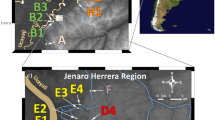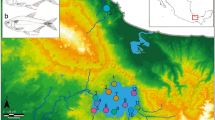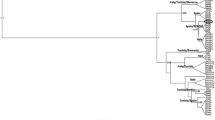Synopsis
Polypatric speciation from an amphidromous ancestor has been suggested for a fluvial gobyRhinogobius flumineus; a similar history may explain life-history and genetic variation inCottus species. We used starch-gel electrophoresis to examine intra- and interspecific genetic differentiation of two siblingCottus species, amphidromousC. amblystomopsis and fluvialC. nozawae, which are presumed to be in an ancestor-descendant phyletic relationship. Genetic differentiation was markedly less withinC. amblystomopsis, than inC. nozawae. One group ofC. nozawae populations was closer toC. amblystomopsis (by Nei's genetic distance) than it was to other populations ofC. nozawae. This suggests that the differentiation of presently identifiable groups ofC. nozawae populations might have occurred polypatrically from an amphidromous ancestral population at different times. The two groups are presumed to be different species in spite of their quite similar morphological and ecological characteristics: we propose to call this type of speciation ‘Polypatric and parallel speciation’. This model of ‘Polypatric and parallel speciation’ might be generalized to explain evolution of amphidromous or anadromous species to fluvial or lacustrine land-locked species.
Similar content being viewed by others
References cited
Allendorf, F.W. & F.M. Utter. 1979. Population genetics. pp. 407–454.In: W .S. Hoar, D.J. Randall & J.R. Brett (ed.) Fish Physiology 8, Academic Press, New York.
Anderson, L., N. Ryman, R. Rosenberg & G. Stahl. 1981. Genetic variability in Atlantic herring (Clupea harengus harengus): description of protein loci and population data. Hereditas 95: 69–78.
Anderson, L., N. Ryman & G. Stahl. 1983. Protein loci in the Arctic charr,Salvelinus alpinus L.: electrophoresic expression and genetic variability patterns. J. Fish Biol. 23: 75–94.
Andoh, T. & A. Goto. 1988.
Ayala, F.J., J.R. Powell, M.L. Tracey, C.A. Mourao & S. Perez-Salas. 1972. Enzyme variability in theDrosophila willistoni group. IV. Genetic variation in natural populations ofDrosophila willistoni. Genetics 70: 113–139.
Balon, E.K. 1981. About processes which cause the evolution of guilds and species. Env. Biol. Fish. 6: 129–138.
Balon, E.K. 1983. Epigenetic mechanisms: reflections on evolutionary processes. Can. J. Fish. Aquat. Sci. 40: 2043–2058.
Bush, G.L. 1975. Modes of animal speciation. Ann. Rev. Ecol. Syst. 6: 339–364.
Chakraborty, R., P.A. Fuerst & M. Nei. 1978. Statistical studies on protein polymorphism in natural populations. II. Gene differentiation between populations. Genetics 88: 367–390.
Chakraborty, R., P.A. Fuerst & M. Nei. 1980. Statistical studies on protein polymorphism in natural populations. III. Distribution of allele frequencies and the number of alleles per locus. Genetics 94: 1039–1064.
Clayton, J.W. & D.N. Tretiak. 1972. Amine-citrate buffer for pH control in starch gel electrophoresis. J. Fish. Res. Board Can. 29: 1167–1172.
Goto, A. 1975a. Ecological and morphological divergence of the freshwater sculpin,Cottus nozawae Snyder — I. Spawning behavior and process of development on the post-hatching stage. Bull. Fac. Fish. Hokkaido Univ. 26: 31–37. (In Japanese).
Goto, A. 1975b Ecological and morphological divergence of the freshwater sculpin,Cottus nozawae Snyder — II. Morphological comparison of adult fishes of small-egg and large-egg types and their distribution. Bull. Fac. Fish. Hokkaido Univ. 26: 39–48. (In Japanese).
Goto, A. 1977. Some consideration on speciation and adaptation of freshwater sculpins in Hokkaido, Japan. J. Michurin Biol. 13: 39–47. (In Japanese).
Goto, A. 1980. Geographical distribution and variation of two types ofCottus nozawae in Hokkaido, and morphological characteristics ofC. amblystomopsis from Sakhalin. Japan. J. Ichthyol. 27: 97–105.
Goto, A. 1981. A consideration on the adaptation and evolution of the freshwater sculpins. Biological Science (Tokyo) 33: 129–136. (In Japanese).
Goto, A. 1983. Spawning habits and reproductive isolating mechanism of two closely related river-sculpins,Cottus amblystomopsis andC. nozawae. Japan. J. Ichthyol. 30: 168–175.
Goto, A. 1990. Alternative life-history styles in the Japanese freshwater sculpins revisited. Env. Biol. Fish. 28: 101–112.
Gyllensten, U. 1985. The genetic structure of fish: differences in the intraspecific distribution of biochemical genetic variation between marine, anadromous, and freshwater species. J. Fish Biol. 26: 691–699.
Hubby, J.L. & R.C. Lewontin. 1966. A molecular approach to the study of genetic heterozygosity in natural populations. I. The number of alleles at different loci inDrosophila pseudoobscula. Genetics 54: 577–594.
Kirkpatrick, M. & R.K. Selander. 1979. Genetics of speciation in lake whitefishes in the Allegash Basin. Evolution 33: 478–485.
Maynard Smith, J. 1966. Sympatric speciation. Amer. Nat. 100: 638–650.
McPhail, J.D. & C.C. Lindsey. 1970. Freshwater fishes of Northwestern Canada and Alaska. Bull. Fish. Res. Board Can. 173: 1–381.
Miyadi, D., H. Kawanabe & N. Mizuno. 1976. Colored illustrations of the freshwater fishes of Japan. Hoikusha, Osaka. 462 pp. (In Japanese).
Mizuno, N. 1960a. Studies on a freshwater goby,Rhinogobius similis Gill, with a proposition on the relationships between land-locking and speciation of some freshwater gobies in Japan. Mem. Col. Sci. Kyoto Univ., Ser. B 27: 97–115.
Mizuno, N. 1960b. Description of a new freshwater goby from Japan. Mem. Coll. Sci. Kyoto Univ., Ser. B 27: 117–119.
Mizuno, N. 1963. Distribution ofCottus japonicus Okada (Cottidae) andTukogobius flumineus Mizuno (Gobiidae), with special references to their peculiarities in both the land-locking and the speciation from amphidromous ancestors. Bull. Osaka Gakugei Univ. 11: 129–161. (In Japanese).
Nakamura, M. 1963. Keys to the freshwater fishes of Japan fully illustrated in colors. Hokuryukan, Tokyo, 260 pp. (In Japanese).
Nei, M. 1972. Genetic distance between populations. Amer. Nat. 106: 283–292.
Nei, M. 1975. Molecular population genetics and evolution. North-Holland, New York. 288 pp.
Nei, M. 1983. Genetic polymorphism and the role of mutation in evolution. pp. 165–190.In: M. Nei & R.K. Koehn (ed.) Evolution of Genes and Proteins, Sinauer Associates, Sunderland.
Nelson, J.S. 1968a. Distribution and nomenclature of North American kokanee,Oncorhynchus nerka. J. Fish. Res. Board Can. 25: 409–414.
Nelson, J.S. 1968b. Variation in gillraker number in North American kokanee,Oncorhynchus nerka. J. Fish. Res. Board Can. 25: 415–420.
Nishida, M. 1986. Geographic variation in the molecular, morphological and reproductive characters of the Ayu,Plecoglossus altivelis (Plecoglossidae) in the Japan-Ryukyu Archipelago. Japan. J. Ichthyol. 33: 232–248.
Richardson, R.H. 1974. Effects of dispersal, habitat selection, and competition on a speciation pattern inDrosophila endemic to Hawaii. pp. 140–164.In: M.J.D. White (ed.) Genetic Mechanisms of Speciation in Insects, Australian and New Zealand Book Company, Sidney.
Ricker, W. 1940. On the origin of kokanee, a fresh-water type of sockeye salmon. Trans. Roy. Soc. Canada. ser. 3, 34. sec. 5: 121–135.
Ridgway, G.J., S.W. Sherburne & R.D. Lewis. 1970. Polymorphism in the esterases of Atlantic herring. Trans. Amer. Fish. Soc. 99: 147–151.
Shaw, C.R. & P. Prasad. 1970. Starch gel electrophoresis of enzymes — a compilation of recipes. Biochem. genet. 4: 297–320.
Sneath, P.H.A. & R.R. Sokal. 1973. Numerical taxonomy. W.H. Freeman & Company, San Francisco. 573 pp.
Sokal, R.R. & F.J. Rohlf. 1981. Biometry. W.H. Freeman & Company, San Francisco. 859 pp.
Takata, K. & A. Goto. 1990. Genetic differentiation of Japanese ninespine sticklebacks, genusPungitius, with reference to their taxonomical status. Copeia (in press).
Tolymachev, A.N. 1956. On Arctic flora of USSR. J. Bot. 41: 783–796. (In Russian).
White, M.J.D. 1978. Modes of speciation. W.H. Freeman & Company, San Francisco. 455 pp.
Wright, S. 1946. Isolation by distance under diverse systems of mating. Genetics 31: 39–59.
Zavadskiy, K.M. 1961. Studies on species. University of Leningrad Press, Leningrad. 254 pp. (In Russian).
Author information
Authors and Affiliations
Rights and permissions
About this article
Cite this article
Goto, A., Andoh, T. Genetic divergence between the sibling species of river-sculpin,Cottus amblystomopsis andC. nozawae, with special reference to speciation. Environ Biol Fish 28, 257–266 (1990). https://doi.org/10.1007/BF00751039
Received:
Accepted:
Issue Date:
DOI: https://doi.org/10.1007/BF00751039




